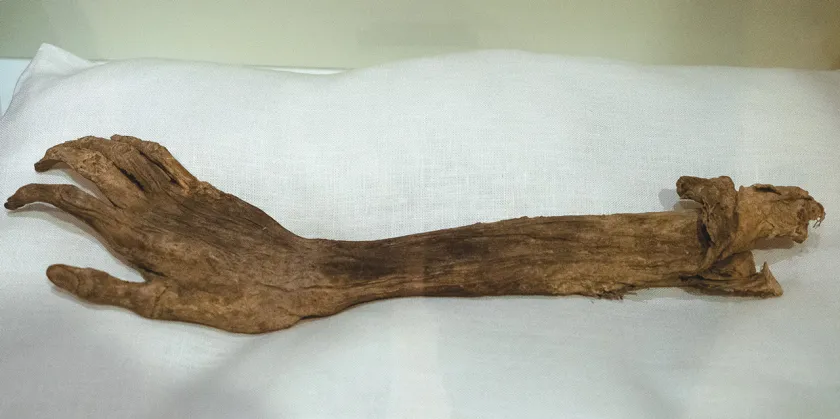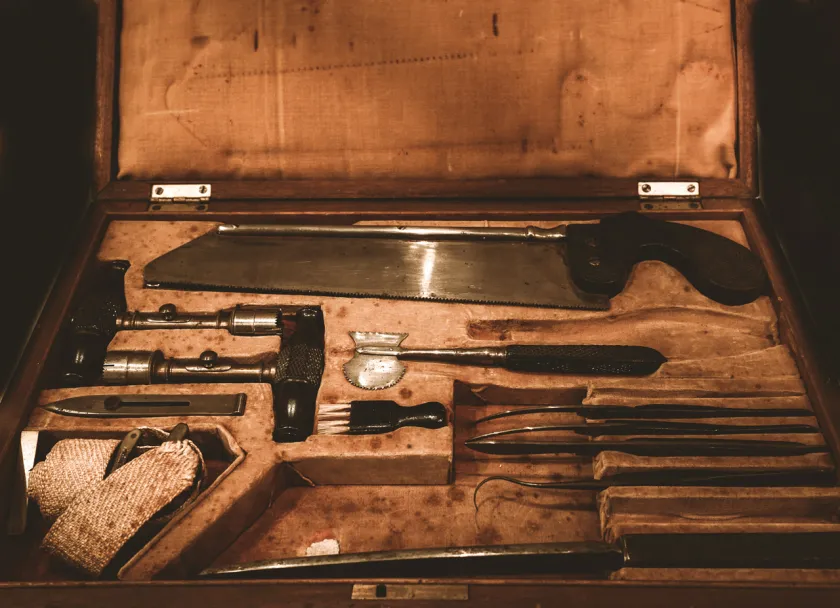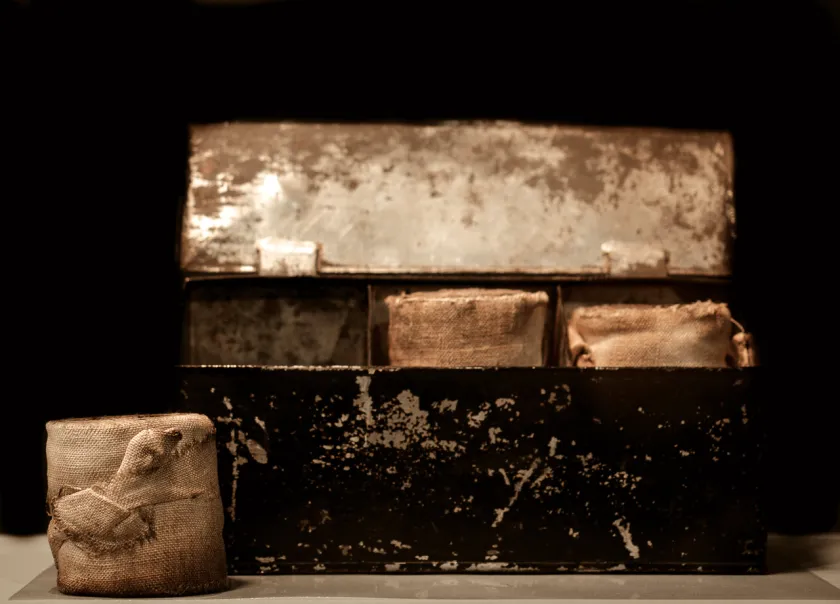
Original pocket surgical kit on display in the National Museum of Civil War Medicine.
In the nation’s bloodiest conflict, there were two wars at play — the one between Union and Confederate forces and the other pitting life against death. As the injured piled up on the battlefields, doctors found themselves inundated with patients. And when injury wasn’t the issue, disease was not far afield.
Chloroform was first introduced as an anesthetic in 1846, well before the American Civil War. Many Civil War surgeons used either chloroform or ether when operating on soldiers, in an effort to reduce the pain felt during surgery. According to Union medical records, over 80,000 surgical procedures took place over the course of the Civil War, with fewer than 300 done without the use of anesthesia, dispelling myths that soldiers drank alcohol or "bit the bullet" during surgery.

Today, many visit battlefields and listen to the stories of the soldiers who fought at these hallowed places. But the war wasn’t fought just at Gettysburg and Antietam, or the thousands of less famous fields where fire was exchanged. There was an underlying battle taking place, even in the years after: the war between life and death.
This fight in the fields and hospitals was not only against the carnage created in battle, but also against more dangerous diseases and infections. What many thought was going to be a one-battle war turned into four years of civil war resulting in more than 620,000 casualties. Even though the medical field had advanced far beyond the realm of the foul humors and scarificators discussed in the 18th century, medical personnel were unprepared for the vast bloodletting. Due to the increased technology and sheer number of wounded experienced following battles, and despite great challenges, the Civil War ultimately propelled the medical field forward into the modern era.
By the 1860s, significant medical advancements had disproved many 18th-century ideologies, such as the humoral theory, which proposed that the imbalance of humors (blood, yellow bile, black bile and phlegm) caused illness. Yet serious studies of anatomy, bacteriology and epidemiology were still in the future. To become a physician, one had to attend medical school but, in some cases, it could be completed solely through book learning, without practicum and observations. As a result, at the outbreak of war, both the Confederate and Union armies were staffed with medical personnel gaining on-the-job experience.
On July 21, 1861, 36,000 troops fought at Manassas, a battle that resulted in 860 soldiers killed and more than 3,500 wounded or missing. In the days following, several challenges immediately came to light. There were not enough surgeons in either army. Most regiments had a surgeon and an assistant surgeon — a pair responsible for as many as 1,000 men — but many of these medical personnel had never seen active combat. Because hospitals were not established until the conflict was underway, supplied Confederate facilities were located four miles to the south at Manassas Junction; Union facilities were seven miles to the east in Centreville.
Thus, in the days following the Battle of First Manassas, this combination of poor organization, little experience, limited mobility and slower action resulted in more deaths. John Opie of the 5th Virginia Infantry described the scene at the Portici Confederate hospital in the hours after the battle:
There were piles of legs, feet, hands and arms, all thrown together, and at a distance, resembled piles of corn at a corn-shucking. Many of the feet still retained a boot or shoe. Wounded men were lying on tables and surgeons, some of whom at the time were very unskillful, were carving away, like farmers in butchering season, while the poor devils under the knife yelled with pain. Many limbs were lost that should have been saved, and many lives were lost in trying to save limbs that should have been amputated…
Elsewhere on the field, a group of unnamed Confederate soldiers came across some Union soldiers left inside the Stone House. One remarked that “in this building were thirty-two wounded, many of them dreadfully mangled by cannon shot. There was but a single surgeon, and he was young and apparently inefficient. Men lay on the floor with their clotted wounds still undressed. Some had died and not been removed.”

What should have been a unified fight for life was divided along lines of North and South. While Union surgeons were treating soldiers at Sudley Church when the rout began, they had to make a decision to leave with their fellow soldiers or stay behind to treat the wounded and be captured as prisoners. The surgeon from the 11th Massachusetts left a soldier on the operating table and ran. Others decided to stay where they were, expecting to become prisoners of war and immediately sent to Richmond, leaving fewer surgeons to care for wounded Union soldiers. They knew Confederate surgeons were already overwhelmed with their own wounded. As a result, in May and June of 1862, Dr. Hunter McGuire and several other surgeons entered into an agreement that remained throughout the rest of the war that effectively made medical personnel neutral:
We surgeons and assistant surgeons, United States Army, now prisoners of war in this place do give our parole of honor on being unconditionally released to report in person, singly or collectively to the Secretary of War in Washington City as such and that we will use our best efforts that the same number of medical officers of the Confederate States Army now prisoners or may hereafter be taken be released on the same terms. And furthermore, we will on our honor use our best efforts to have this principle established — the unconditional release of all medical officers taken prisoners of war hereafter.
This was immediately supported by Secretary of War Edwin Stanton in June 1862, who issued Special Order No. 60, which “immediately and unconditionally freed all Confederate doctors held prisoner.”
While the battle lines of the war against wounds and disease had been unified, there were other challenges the medical field experienced between 1861 and 1865 that would severely impact the chances of survival for soldiers.
One of the most significant was the sheer number of wounded. Following First Manassas, the numbers only increased: 17,300 at Antietam, 13,700 at Fredericksburg and 33,200 at Gettysburg. Sgt. Jacob Fryberger of Company K, 51st Pennsylvania Infantry recalled the sickening site at Antietam, writing, “I have seen more than I ever expected to see. I have laid on the field in front of the enemy, where the dead and wounded were laying in heaps around us.”
A New York Tribune reporter making his way to the Antietam Battlefield on September 18 was staggered by the scale of the carnage and the seemingly endless number of ambulances. He wrote:
[T]he wounded are coming in by the thousands … around and in a large barn… I counted 1,250 wounded. Along the same road and within the distance of two miles are three more hospitals each having from 600 to 700 in them, and long trains of ambulances standing in the road waiting to discharge their bloody loads. Surgeons with hands, arms and garments covered with blood, are busy amputating limbs, extracting balls and bandaging wounds of every nature in every part of the body.
Shortly after the Battle of Gettysburg, the town appeared to become one huge hospital full of pain and suffering. A correspondent to Philadelphia’s Public Ledger described the scene on July 15, 1863:
This town, and the vicinity with a space of country surrounding it of eight or ten miles, is literally one vast and over-crowded hospital. In the town itself, every available space has been freely given up by the citizens to the sufferers, and yet on this, the ninth day after the battle, several thousands are lying, with arms and legs, amputated and every other kind of conceivable wound, in tents, in the open field, in the woods, in the stables, barns, and some of them even on the bare ground without cover or shelter.
As the war progressed, the number of wounded increased even as supplies dwindled, yielding a greater loss of life from exposure, poor nutrition and disease. Such issues were experienced as early as 1861, as articulated by a soldier of the 5th Alabama at the Confederate Batteries of Cockpit Point off the Potomac River:
[W]e being from Alabama where the winters are not so severe, considered this winter of 1861–1862 the coldest of our lives and this high point on the Potomac, the coldest in America. So it seemed to us, and we came near freezing and starving to death that winter. We were away off to ourselves, and the roads were impassible from the rains and freezes, and rations became an item for the first time in our war life.
What’s worse, the soldiers at Cockpit Point did not have proper medical personal. One officer wrote from the Potomac River batteries, “Sir, I respectfully beg leave to report that commands in Brigadier General Whitings Brigade that are destitute of properly authorized Medical Officers. Capt. Frobels Battery at Cockpit Point has no properly authorized medical officer, neither has Capt. Rileys light battery at Camp Fisher.”
Issues such as food and staff shortages, exposure to the elements and increasing numbers of casualties led to another problem even more dangerous than that found on the battlefield: disease. The men who joined up came from a variety of backgrounds and locations, bringing together individuals with differing exposure to diseases and levels of immunity. This, compounded by a lack of sterilization; a crowded, unsanitary environment; and limited knowledge of germs, made disease deadlier than battle wounds. Over the course of the Civil War, two-thirds of soldiers’ deaths were caused by disease and infection, rather than injuries. Soldiers were treated not only for battle wounds, but also illnesses such as dysentery, typhoid, measles and smallpox.

At Centreville, Virginia, during the winter of 1861–1862, Confederate officer John B. Gordon, who eventually rose to the rank of major general, remarked:
There was much sickness in camp. It was amazing to see the large number of country boys who had never had the measles. Indeed, it seemed to me that they ran through the whole catalogue of complaints to which boyhood and even babyhood are subjected. They had everything almost except teething, nettle-rash, and whooping-cough. I rather think some of them were afflicted with this latter disease.
In the fall 1862, almost 500 cases of malaria and yellow fever appeared throughout Wilmington, North Carolina, as military-built breastworks created stagnant ponds throughout the city. Even medical personnel themselves were subject to disease while treating soldiers. Louisa May Alcott nearly died of typhoid while working at a hospital in Washington, D.C. Adam Michael had his parlor used as a hospital following the Battle of Antietam and wrote later that winter, “[T]he disease … has afflicted three of our family… Mother died with this disease on the 25th day of November.”
These are just a few examples of the challenges the medical field faced over the course of the Civil War. With more than 620,000 casualties, mistakes were made and lessons learned, ultimately propelling medicine into the modern era. One of the most significant advancements to result from the Civil War was the Medical & Surgical History of the War of the Rebellion from Circular No. 2, passed on May 21, 1862, and Circular No. 5, passed on June 9, 1862. Passed by Dr. William Alexander Hammond, a military physician and neurologist, and surgeon general of the United States from 1862 to 1864, the circulars established the Army Medical Museum for the purpose of “illustrating the injuries and diseases that produce death or disability during war, and thus affording materials for precise methods of study or problems regarding the diminution of mortality and alleviation of suffering in armies.” It directed medical personnel to collect and forward to the surgeon general all specimens of morbid anatomy
regarded as valuable, along with any projectiles and anything else deemed useful for the study of military medicine or surgery.

These incredibly significant directives created an unprecedented number of specimens for study on a scale never before seen in American medicine and allowed for the opportunity to develop new ideas about medicine and disease. Circular No. 5 passed just a few weeks after Circular No. 2 and required medical officers to submit reports with all specimens sent to the museum. This included “sanitary, topographical, medical and surgical reports, details of cases, essays and the results of investigations and inquiries as may be of value.” By the end of the war, an enormous number of reports and images were available for study. Even 131 years later, medical personnel and historians still utilize the information presented in The Medical and Surgical History of the War of the Rebellion. The images, cases, statistics and analyses in a now 15-volume set provide not only primary accounts into the suffering endured during the Civil War, but also the advancements that came of the conflict.
Through these experiences and materials, as well as the shift toward anatomical study and scientific analysis, the fields of bacteriology, reconstructive surgery, orthopedics and prosthetics were propelled into the modern era that many take for granted today. When you break a bone, get sick or have a cut that gets infected, I encourage you to think about the sacrifice these men gave so that we can live long and healthy lives today.






